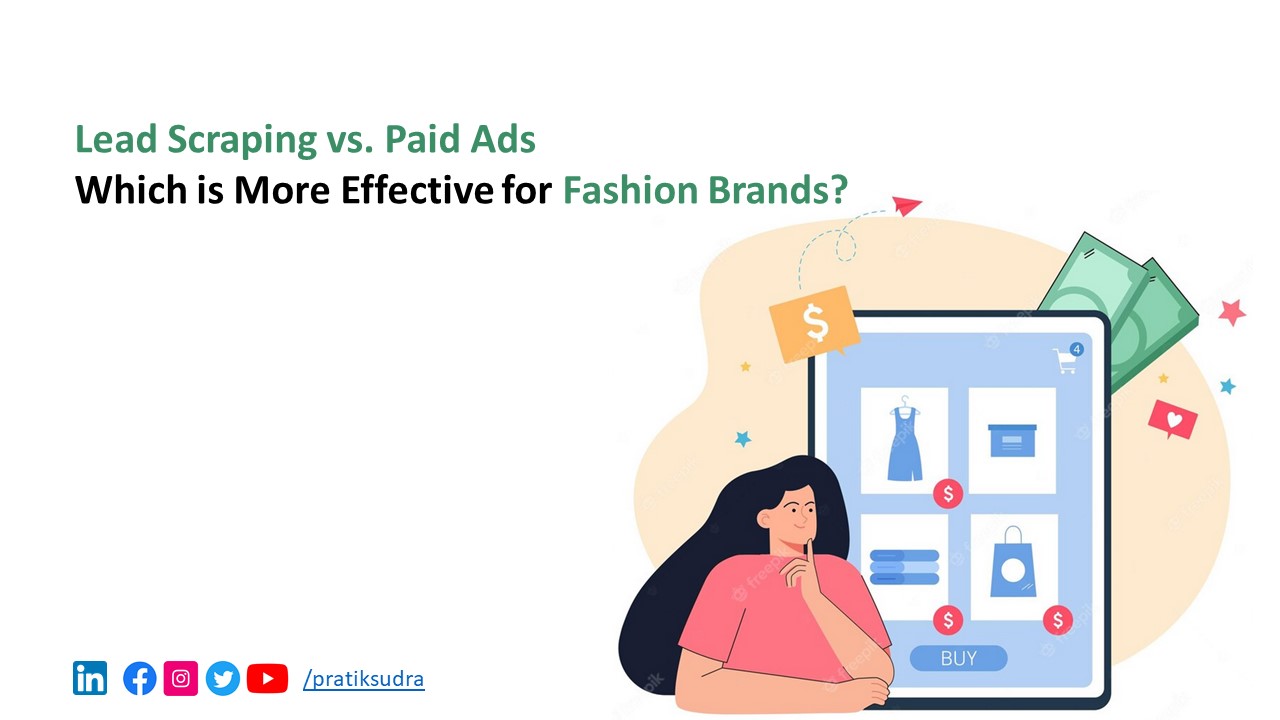Introduction:
In the digital age, fashion brands have numerous options to promote their products and attract customers. Lead scraping and paid advertising are two popular strategies, each with its own benefits and challenges. In this blog post, we'll explore the effectiveness of lead scraping and paid ads for fashion brands, highlighting their implementation in a phased approach and the tools required to execute these strategies successfully.
Lead Scraping
Lead scraping involves extracting contact information and other relevant data from various online sources. It can be an effective way for fashion brands to generate leads and build their customer base. Here's a phased approach to implementing lead scraping:
-
Identifying target audience:
Begin by defining your target audience, considering factors such as age, location, interests, and style preferences. This will help you tailor your lead scraping efforts accordingly. -
Researching online platforms:
Determine the online platforms where your target audience is most likely to engage with fashion content. These may include fashion blogs, social media platforms, fashion forums, and online communities. -
Extracting contact information:
Utilize scraping tools like BeautifulSoup or Scrapy to crawl through web pages and extract relevant contact information, such as email addresses and social media handles, from fashion-related websites and platforms. -
Organizing and analyzing data:
Store the collected data in a structured format, such as a customer relationship management (CRM) system. Analyze the data to identify patterns, preferences, and potential leads that can be effectively targeted in marketing campaigns. -
Personalized outreach:
Craft personalized email campaigns or engage with potential leads through social media to establish a connection. Provide value through exclusive offers, personalized recommendations, and relevant fashion content to nurture relationships with potential customers.
Tools for lead scraping:
- BeautifulSoup: A Python library for web scraping, allowing you to parse HTML and XML documents.
- Scrapy: A versatile and scalable web scraping framework that simplifies data extraction from websites.
- CRM software: Customer relationship management software helps organize and manage customer data effectively.
Paid Ads
Paid advertising enables fashion brands to reach a wider audience and increase brand visibility. Here's a phased approach to implementing paid ads effectively:
-
Defining advertising objectives:
Determine your goals for paid advertising, such as increasing brand awareness, driving website traffic, or boosting sales. This will help you design targeted ad campaigns. -
Choosing ad platforms:
Identify the most relevant advertising platforms for your fashion brand. Popular options include Google Ads, Facebook Ads, Instagram Ads, and influencer collaborations. -
Targeting options:
Utilize the targeting options provided by the ad platforms to narrow down your audience based on demographics, interests, behavior, and other relevant factors. This ensures that your ads reach the right people. -
Ad creation:
Design visually appealing and engaging ads that align with your brand image and message. Use high-quality images, compelling copy, and clear calls-to-action to capture audience attention. -
Monitoring and optimization:
Continuously monitor the performance of your ad campaigns, tracking key metrics such as click-through rates (CTR), conversions, and return on ad spend (ROAS). Make data-driven decisions to optimize your campaigns and improve results.
Tools for paid ads:
- Google Ads: Google's online advertising platform that offers a wide range of ad formats and targeting options.
- Facebook Ads Manager: Facebook's advertising platform that allows you to create and manage ad campaigns across Facebook, Instagram, and other platforms.
- Social media management tools: Tools like Hootsuite or Sprout Social can help you schedule and manage your social media ad campaigns effectively.
Example Implementation:
Fashion Brand X
Fashion Brand X is a new online clothing retailer targeting young adults interested in sustainable fashion. They want to implement a marketing strategy using both lead scraping and paid ads to effectively reach their target audience and optimize their results. Let's see how they can implement and optimize their approach based on the guidelines mentioned in the blog.
Lead Scraping
-
Identifying target audience:
Fashion Brand X defines their target audience as environmentally conscious individuals aged 18-30 who value sustainable and trendy fashion. -
Researching online platforms:
They identify popular fashion blogs, sustainable fashion communities, and social media platforms like Instagram and Facebook as key online platforms where their target audience is likely to engage. -
Extracting contact information:
Fashion Brand X uses scraping tools like BeautifulSoup and Scrapy to extract email addresses and social media handles of users who have expressed interest in sustainable fashion, either through blog subscriptions or engagement on social media. -
Organizing and analyzing data:
They store the collected data in a CRM system, categorizing leads based on preferences, engagement, and potential customer value. They analyze the data to identify patterns in consumer behavior and preferences, allowing for personalized marketing campaigns. -
Personalized outreach:
Fashion Brand X crafts personalized email campaigns that offer exclusive discounts on sustainable fashion items and share informative content on eco-friendly fashion choices. They also engage with potential leads on social media by liking and commenting on relevant posts and sharing fashion tips and trends aligned with sustainability.
Paid Ads
-
Defining advertising objectives:
Fashion Brand X's advertising objectives are to increase brand awareness and drive traffic to their website. -
Choosing ad platforms:
They decide to focus on Instagram and Facebook Ads, as these platforms have a strong presence among their target audience. -
Targeting options:
Fashion Brand X utilizes targeting options provided by the ad platforms to narrow down their audience by location, age, interests (sustainable fashion, eco-conscious living, ethical brands), and behavior (engagement with similar fashion brands or sustainable fashion content). -
Ad creation:
They create visually appealing ads featuring models wearing their sustainable fashion items in trendy settings. The ad copy emphasizes their commitment to sustainability, quality, and unique designs. Clear calls-to-action prompt users to visit their website or explore their collection. -
Monitoring and optimization:
Fashion Brand X actively monitors their ad campaigns, tracking metrics such as CTR, conversions, and ROAS. They analyze the data to identify the best-performing ads, demographics, and interests. Based on the insights gained, they optimize their campaigns by reallocating budget towards high-performing ads, refining their targeting options, and testing new ad creatives to continuously improve results.
By implementing both lead scraping and paid ads, Fashion Brand X can generate a steady stream of leads through personalized outreach and create brand awareness through targeted ad campaigns. They can optimize their results by following the guidelines mentioned in the blog, continuously analyzing data, and making data-driven decisions to refine their marketing strategies.


